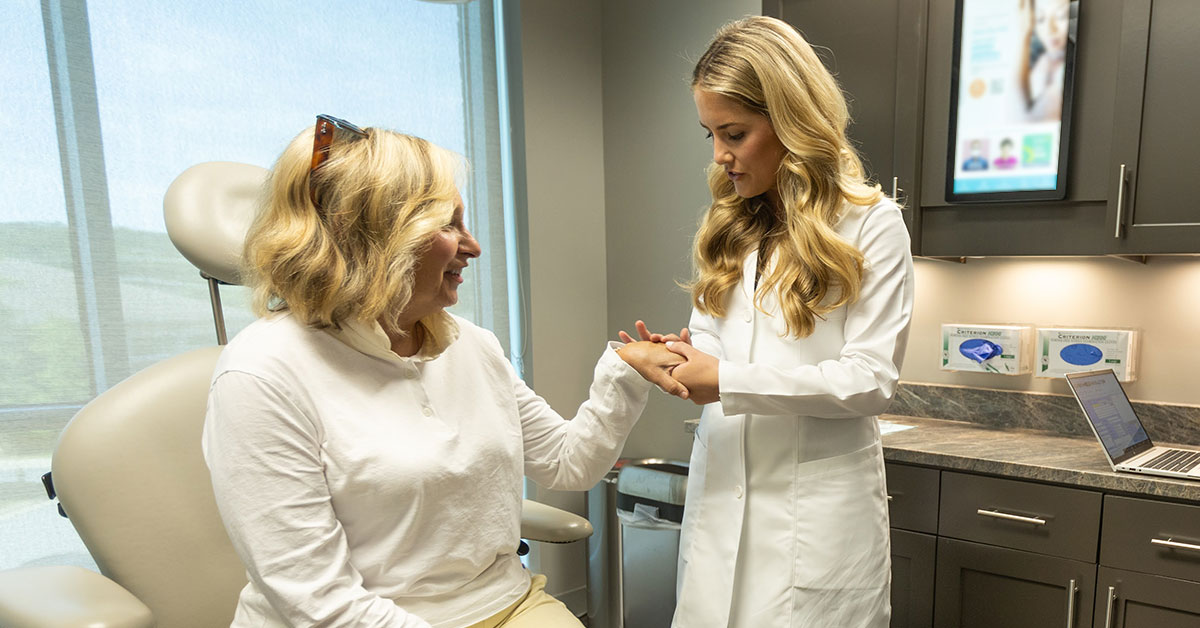Signs of Skin Cancer: Basal Cell Carcinoma

Basal Cell Carcinoma
The most common form of skin cancer, basal cell carcinoma is often caused by prolonged exposure to UV radiation from the sun or tanning beds. It can also occur in areas of your skin previously compromised by radiation therapy, burns, or inflammation.
Understanding Basal Cell Carcinoma
Basal cell carcinoma (BCC) develops in the basal layer of the epidermis. Basal cells produce new skin cells and push older cells toward the surface of the skin. When these cells become abnormal, they can divide and grow uncontrollably, forming a tumor that leads to skin cancer.
Signs of Basal Cell Carcinoma
Successful treatment requires early detection of BCC. Therefore, to increase the odds of catching it early, perform regular self-assessments.
Here are some signs to be on the lookout for when checking your skin for BCC:
Open Sores
BCC can present as open sores that fail to heal even after several weeks. These sores may bleed or crust over and feel tender to the touch. They can appear as an ulceration or erosion on the skin and can look either round or irregular. The edges of these sores are usually not well-defined, and the center of the sore may have a raised, pearly border.
Raised Bumps
Raised bumps on the skin that look pearly or translucent can indicate BCC. These bumps may be itchy or tender and can have visible blood vessels on the surface. They are typically round or oval and range in size from a few millimeters to several centimeters. A color and/or texture change may accompany them—for example, they may appear reddish or scaly.
Scaly Patches
BCC can appear as scaly patches or plaques on the skin that are red, pink, or brown. These patches may be itchy or painful and may crust over or bleed. They often look like a patch of eczema, psoriasis, or other skin condition. These patches may be round or irregular.
Waxy Bumps
Bumps on the skin that look firm and shiny could indicate BCC. These bumps can be white, pink, or yellow. They often look like a wart or a skin tag. They may be round, oval, or irregular in shape, and they can range in size from a few millimeters to several centimeters.
Flat Growths
Flat, flesh-colored growths on the skin that look scaly or crusty in appearance may be a sign of BCC. These growths may look raised or elevated and may cause itching or pain. They can present in a range of round, oval, or irregular shapes and can span from tiny to a few centimeters in diameter. They often look like a scar or a mole.
Persistent Itching
Another potential symptom of BCC is persistent or recurrent itching in the affected area. However, it’s important to note that this symptom is not unique to BCC—it could also be caused by other skin conditions.
Pain or Discomfort
Some BCCs can cause pain or discomfort in the affected area, especially around the face or near a joint. Other signs may accompany this symptom, such as itching or tenderness.
If you notice any of these signs on your skin, schedule an appointment with Dr. Franks as soon as possible. Early detection and treatment of BCC can greatly increase the chances of successful treatment and help prevent cancer from spreading to other parts of the body.
Treating Basal Cell Carcinoma
There are several treatment options available for BCC. Some of these include:
- Surgical excision removes the cancerous tumor and a small amount of surrounding tissue. It is usually done under local anesthesia and may require several stitches or a skin graft.
- Cryotherapy freezes the cancerous tumor using liquid nitrogen, which is applied to the tumor with a spray gun. The liquid nitrogen causes the cells in the tumor to freeze and die. This procedure is commonly done in the office and takes only a few minutes. Cryotherapy is an effective treatment option for small, early-stage BCCs on the skin’s surface that can be easily seen and accessed.
- Electrodesiccation and curettage involves using a small electric needle to destroy the cancerous tumor and scraping it off the skin with a curette. This procedure is performed in the office and may require one to two treatments.
-
- Typically used for small or low-risk BCCs, topical therapy involves applying a cream or gel to the tumor that works to slow down or stop the growth of the cancer cells.
- Photodynamic therapy involves applying a special cream to the skin which is then activated by a light source. It is often used for BCCs that are located in hard-to-reach areas or that have recurred after previous treatment.
The best treatment option for you will depend on several factors, such as the size, location, and aggressiveness of the cancer, as well as your overall health and preferences. Additionally, Dr. Franks will work with you to develop a treatment plan tailored to your specific needs.
Contact Franks Dermatology About Basal Cell Carcinoma
At Franks Dermatology, our team of specialists provides client-centered care. We understand the importance of early detection and treatment of BCC, and our team will work with you every step of the way to ensure that you receive the best care possible.
We encourage you to pay attention to the signs of BCC and schedule an appointment with us by calling (501) 246-1042 if you notice any suspicious changes on your skin. Because with the right treatment plan, you can increase the chances of successful treatment and prevent cancer from spreading to other parts of your body.
